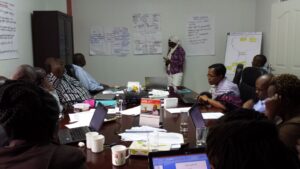Integrating gender in USAID ASSIST Kenya activities: A versatile approach for addressing local and national issues
By Megan Ivankovich on June 22, 2015

As leaders of the gender integration work within the USAID ASSIST Project, we at WI-HER LLC have frequently commented on the versatility of our approach. Utilizing quality improvement principles and tools, we have stated that our 6-step approach to integrate gender can be applied to any topic in any field. The hard work of the USAID ASSIST Kenya team made this claim come to life.
In May 2015, I had the privilege of visiting Nairobi to lead the USAID ASSIST Kenya team in a 3-day training on gender and gender integration in order to strengthen quality improvement efforts during project design, implementation, and evaluation. The USAID ASSIST Project in Kenya aims to foster improvements in a range of health care processes through the application of modern improvement methods by host country providers and managers in USAID-assisted countries. It is unique program because it works at two levels, including at the community level by supporting quality improvement teams as well as at the national level to strengthen QI policies and dissemination. The gender integration training included sessions on defining gender and related concepts, gender analysis, sex-disaggregated and gender-sensitive data collection and analysis, identifying and addressing gender issues and gaps, and documenting and sharing results. There were also plenty of opportunities for practical application of concepts and tools, personal reflection, knowledge exchange, and planning.
There were approximately 17 participants, all from the ASSIST Kenya team. Participants were split up into functional small groups based on their teams. Throughout the training, small group activities were meant to build upon each other using knowledge and skills learned and to apply to participants’ work. Each group was asked to select a problem related to their work in OVC, health service delivery, or policy. In these small groups, participants conducted a gender analysis on their selected problem, developed relevant sex-disaggregated and gender-sensitive indicators, analyzed real data related to their problem, if available, and identified and addressed gender-related issues and gaps by analyzing significant issues and gaps and designing changes to test. On day 3 of the training, each small group shared their work from each of the small group exercise in a cumulative presentation.
Most small groups focused on issues common to ASSIST activities such as low HIV testing rates among men or low skilled delivery. However, one group focused on national-level policy decided to apply our gender integration approach to the national 2/3 gender majority principle in political representation mentioned in the 2010 Kenyan constitution. This policy states that women should occupy at least 1/3 of the seats in County Assemblies as well at least 1/3 of the seats in the Senate, thus promotes the participation of women and men at all levels of governance and makes provisions for proportional representation. While this isn’t a policy issue the team is addressing through ASSIST, the group opted to carry this problem through all small group activities and was able to successfully apply our gender integration approach and tools to this national issue. Due to its relevance to all Kenyans, the group often had passionate debates about the social and structural consequences and potential solutions to this problem, such as the pros and cons of capping campaign funds, and occasionally attracted comments from other groups. By the end of the training, the group succeeded in coming up with specific and feasible changes to test to ensure the 2/3 gender majority principle is achieved.
Gender issues affect each of us every single day and so discussions during gender integration trainings can be impassioned and at times emotional. The Kenya training was no exception. The team was incredibly engaged, participatory, and interactive throughout the three days and eager to share their opinions and experiences related to gender. The topics of gender and gender integration were not new to many participants, and the team seemed to understand the concepts very well. By allowing groups to apply these concepts to their work and giving them the space to reflect on and apply related concepts, some participants stated that it changed the way they think and many left the training thinking about specific ways to address gender in their work. I look forward to following the continued success of the USAID ASSIST Kenya team and supporting as they promote gender equality though ASSIST activities.